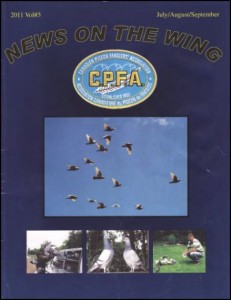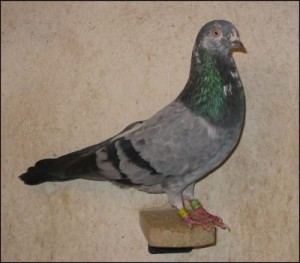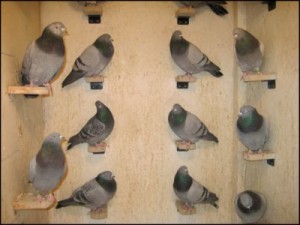by Luka Kapac
Secreteary/Treasurer, Canadian National Tippler Union
[Click Here for PDF Version]
The following article was published by the Canadian Pigeon Fanciers Association and written by yours truly to try and inform the fancy and promote the English Flying Tippler here in Canada. This is how the article appeared in their news magazine.
The Tippler is a unique breed of pigeon bred for its endurance and stamina. It comes in a variety of colours and patterns that will satisfy even the most finicky fancier. The development of the breed is originally from England around or before 1840. Currently there is much misrepresentation of the Flying Tippler throughout the pigeon fancy. One only has to go on You Tube to see any and all high flying breeds also being referred to as Tipplers. This, in fact, is a huge distortion of the true Flying Tippler. Indian and Pakistani high fliers are being referred to as Tipplers, which they are simply not. The word “Tippler” is an English word for a specific breed of pigeon developed in England and not a generic term for any long and high flying pigeons bred elsewhere. We at the Canadian National Tippler Union are dedicated to the preservation and promotion of the breed and have been pressed to amend this distinction in our own constitution by further defining the breed as English Flying Tipplers to clarify any wrongly labelled comparison to another breed of high flier. The other concern currently plaguing the fancy is the decimation of the breed by the relentless birds of prey. In countries such as England, Australia and now Canada the problem has reached epidemic proportions. Most fanciers are experiencing substantial losses. Heavy losses are quite understandable considering the birds are subject to train long periods of time for condition and therefore the odds of an attack increase substantially. However, none of these issues have deterred the passionate and the committed fanciers who are still dedicated to the cause.
The tippler is a magnificent creature having no equal in the pigeon kingdom. The endurance ability of the tippler is but to marvel at. It is of medium build, similar to a roller, but the flying prowess of the racing homer as far as endurance is concerned. The current Canadian Tippler record (old birds) is 18:00 hours by Oskar Zovich and North American record by Michael J. Beat with 18:05 hours of non stop flying, while in the UK 20 hours are done with regularity. The world record is held by Harry Shannon of Northern Ireland with a time of 22:05 hours established with 3 yearling hens back in 1995. The tippler peaks as a yearling although fanciers have flown them as 2 and 3 year olds, but seldom. This is surprising to most and especially to other performing breeds such as rollers and racing homers. As we all know racing homers truly come into form in the latter years, a complete contradiction to the tippler but nevertheless true.
So how does the Tippler perform such great times? First of all it is a bird that loves to fly and it has the parts and the breeding to be able to do so for long periods of time. With that inherent ability, if trained correctly, it can fly even at night for hours. Yes I said night flying for hours. Training is the key to any performing breed and this one is no exception. The birds are trained from an early age of about 4 weeks. With this breed the losses during settling are staggering in some cases, depending on the strain and loft position. The youngsters tend to strike up and touch the clouds never to return. In other words, they are stronger on the wing than in the brain at this early stage. So it is doubly important to keep them very hungry and keen for it is only in this state that they will pay any attention to you and your signal. Another ingredient for good settling percentages is the use of intelligent placid droppers. Droppers are usually birds of lighter colour and good temperament. The reason for the lighter colours is so that if trained to fly at night they can be seen easier by the kit. A dropper is usually a non flying breed such at the tumbler, West of England being very popular, but any non flying breed will do. The desired dropper may do some flying but it is short and around the loft only. This is important as you do not want your droppers flying too long. Instead, they should act like a magnet and create the pull to the loft.
Let us assume that we have settled half dozen youngsters and are now starting their training. The birds are put on a depurative very low in fat and protein but high in carbohydrates. Some fanciers mix their own depurative which is generally a combination of large part barley, up to 70%. We also add wheat and some milo and a really small amount of flax seed to keep the youngsters in form. I usually mix 75% barley and 25% wheat with a pinch of milo and sometimes a tiny pinch of oil seeds such as rape the night before a training fly. By the way, this is a base suggestion as there are many fanciers that use slightly different formulas but generally speaking they are somewhat close to what I have just mentioned.
Birds are always released with darkness or dusk in mind. By that I mean they are flown towards the sunset. This process instils in their brain a routine to only drop at dusk thus ensuring a more predictable result. I guess you could call it imprinting to the dark. The start of training begins by flying only an hour or so, then two, then three and so on. In other words stamina is built gradually and only on a high carb mixtures. If the mix is too rich you will get the hours quickly but the condition will start to deteriorate after time and the birds will become fat, lazy or as tippler fanciers call it “going stale”. This of course is the end of the competition tippler as they will develop bad habits and drop before the droppers are deployed or even worse, land somewhere else. Once a tippler has made a few mistakes it is worthless for competition. During competition their training and stamina will be put to the test and if not disciplined properly they will never achieve big flying times. They will most likely repeat and revert back to the bad habits they exhibited during training. For this reason I re-emphasize the use of high carb mixes and small portion amounts, contrary to what most would think. We will eventually use richer feed later on but this will be during the feed-up, which I will elaborate on shortly.
The kit is now training about 8 hours twice a week and flying on two days rest or three if family commitments and work take precedent, as they usually do. They are responding well and are coming to the droppers nicely. Tipplers that have made mistakes, by this time, are removed from the kit so as not to spoil the rest. The remaining birds which are mistake free are positioned for a competition fly with at least a team of three being the minimum requirement. After each fly you will give them higher amount of protein and oil seeds but not too much – you do not want to put them off condition. I usually give about 15mg of a richer mix followed by liquid electrolytes to replenish the loss of salts and minerals. After a training fly they go back on the high carb mix as mentioned earlier. With the kit doing well, we now set out sights on a competition date. Just to reiterate, a kit is a group of tipplers with 3 being the minimum requirement to fly in a club sponsored competition.
Well the big day is only a week away and we will be competing on a Sunday. The last day that we want to train the kit is most likely a Monday but preferably a Tuesday. The last training fly should be a tad longer as this will deplete the system further and ensure a good feed intake by each kit member during the feed-up. A 4 day feedup seems to be the preferred choice but fanciers do fly on 3 or 5 day feed-ups just the same. Now, there are as many formulas as there are fanciers. I cannot tell you which is better. It depends on many variables such as the strain, training method, flying position, weather conditions are always taken into consideration and so on. But it is generally accepted and agreed upon that we start off with high protein mixes the first day or two and end off with high carbs and fats the latter 2 days. Seeds high in fat and carbs contain most amount of energy especially the fats, having a higher concentration of energy of about 2.5 times than carbs. We also have the option of single or double daily feeding. I have tried both and have no preference other than it depends on the condition of the kit, the temperature and the weather conditions on competition day. If all goes well and the ever present hawks/falcons leave us alone we hope to fly from the dawn of the early morning to the dark of the late evening.
Let me emphasize something which I have not mentioned in this article and that is the importance of obtaining a good sound strain. I know fanciers of any breed understand and agree this to be the golden rule by starting with the best you can find and afford. The philosophy holds true with the tippler as well. You will experience much more pleasure and enjoyment rather than disappointment, and this I can guarantee. No tippler will fly long hours unless it is of a proven working strain tested time and time again. To start you will need only 2-3 pairs of one strain. The reason I suggest a single strain is because it will give you the uniformity in flight. This is extremely important so that each bird will complement the other rather than work against the team concept and thus wasting valuable energy needed for an all day fly.
There are more facets to the breed and hobby which could take me an entire issue to uncover but I hope I have given you some idea of just how fascinating the English Flying Tippler really is. Like any passionate and proud organization we at the CNTU believe the tippler has no equal and is suitable for anyone into the performance aspect of the fancy. In closing I would just like to say the tippler is a pigeon of fantastic ability but only if handled and trained properly.
We also placed a half page ad for 2011 in the CPFA magazine to promote the club…



